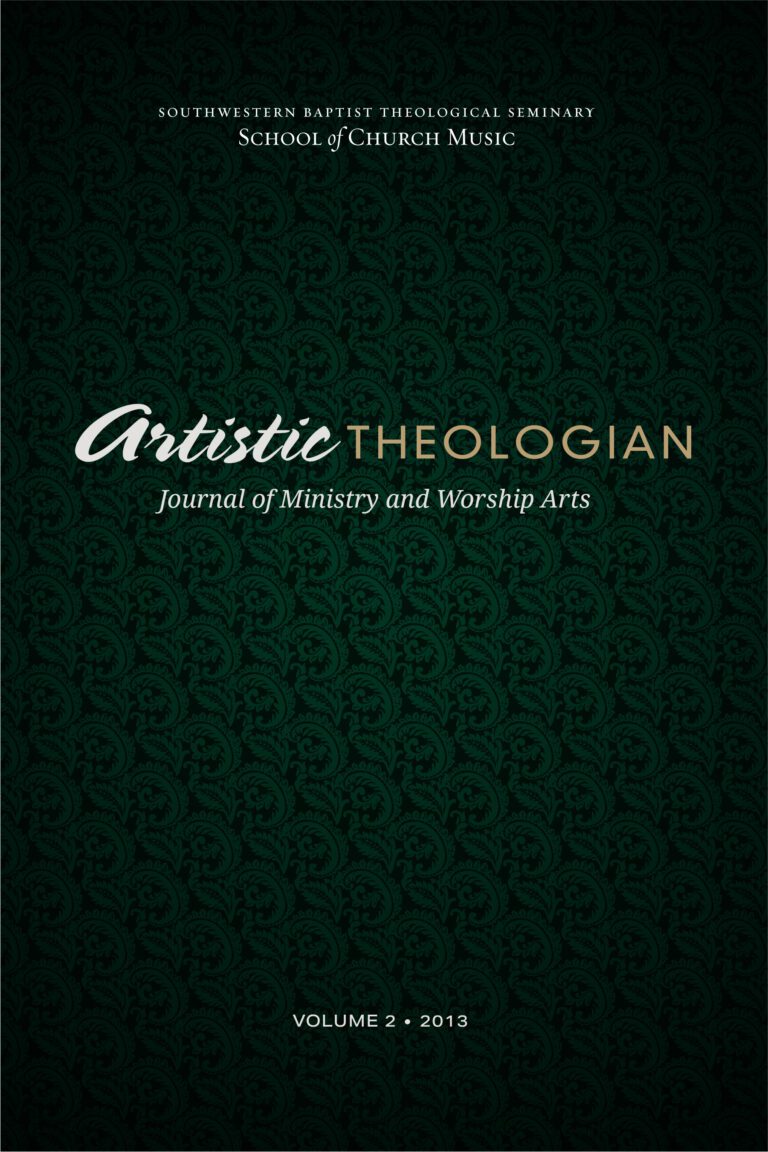
Worship Ministry: An Intersection of Ideas
Artistic Theologian
Volume 2, Summer 2013
Editor-in-Chief: John E. Simons
Worship on Earth as It Is in Heaven: Exploring Worship as a Spiritual Discipline, by Rory Noland. Grand Rapids: Zondervan, 2011. 240 pp. $16.99.
Worship on Earth as It Is in Heaven is one of a series of books by Rory Noland, a graduate of Chicago Musical College who served as music director at Willow Creek Community Church for twenty years. He now directs an organization designed to serve artists in the church and is in demand as a speaker, consultant, and mentor to worship leaders. Arranged in a format convenient for personal reading or small group study, each chapter ends with discussion questions and a brief encouragement directed to pastors and worship leaders. Part One addresses private worship, using the Psalms to illustrate David’s expressions of personal worship, while Part Two uses passages from Revelation to discuss corporate worship. In addition to biblical texts, both sections are sprinkled with relevant quotations from a variety of well-known writers on the subject.
Part One gives some helpful insight into the Psalms as the author takes a candid look at David’s personal worship life. The first two chapters encourage making personal worship a priority by establishing a regular routine. The third chapter helps the reader see that idolatry takes many shapes and forms and presses the need to examine who or what is being worshipped. Chapter four takes readers on a journey through the many facets of how worship can transform them in the midst of challenging times by looking at the way David responded to adversity. The supportive passages that accompany each point are clearly explained and given relevant application.
In “Growing as a Corporate Worshiper,” Noland uses several passages from Revelation to support a conclusion that heavenly worship is loud and repetitive. Those who object to worship possessing these characteristics are challenged to cultivate a teachable attitude. Furthermore, he gives a plan for focusing on God’s attributes as an approach to dealing with the things that distract our attention in worship and then encourages giving your best in worship by being passionate, exhibiting visual Biblical worship postures (e.g., lifting hands), while making your worship audible by singing loud.
In Chapter 7, “Welcome All Ages: Setting Aside Personal Preferences,” Noland gives some statistics describing the alarming void of attendees from the “twenty-something” age group. He believes intergenerational worship rather than age-segregated services is an important part of reaching this generation and gives a summary of the common age groups with their characteristics as he develops his reasoning. He concludes that attendance should be a “younger look with an older presence.” By slanting worship planning towards a younger demographic, he believes this trend can be reversed and thus encourages those in the other demographics to “set aside personal preferences.”
Noland concludes his book by challenging churches to embrace diversity and strive to become “multiethnic.” After helping the reader to see the many advantages of this journey, he presses further in a section titled “In Defense of Rap (and Other Contemporary Styles).” Here he clarifies his philosophy of music in worship by explaining the following guidelines: 1) Consider the words; 2) Don’t misjudge the artist’s motives; 3) Avoid generalizations, stereotypes, and assumptions; 4) Music is neither right nor wrong; 5) Negative associations with music can be reversed. This personal manifesto of sorts gives the reader some clearer insight into Noland’s philosophy that has guided much of his thinking throughout the book.
Regular readers of Artistic Theologian might label Noland’s ideas as a typical pragmatic approach. Making text the all-encompassing determinant of music’s appropriateness for worship embraces all forms of musical style, presentation, genre, and so forth as scripturally permitted as long as the “message” is good. Noland’s pragmatic approach seems to lead him in Part Two to sacrifice careful analysis of biblical texts in an effort to substantiate or affirm many practices that he values in corporate worship. His tone becomes critical at times as he recounts anecdotes of church members who objected to various aspects of his ministry through the years, such as the sound system being too loud, a musical style they didn’t like, or an absence of their preferred style.
One would expect to see substantive scriptural and logical support to Noland’s ideas, but his evidence is subjective and based largely on his experience. The view that “music, without the words, is amoral” is at the heart of today’s controversy in worship and needs a depth of discussion and explanation that is absent here. One would need to construct a large biblical framework to support a personal manifesto with these far-reaching implications. In describing the rap singer sharing in worship at his church, Noland alludes to some ways that the individual was carefully screened, but never gives a comprehensive analysis of considerations beyond just musical style and text. What is the context? How is it presented? What is its purpose? What about the quality of performance? What Scripture addresses the situation? Leaving the door of musical selection so widely open may easily invite worldliness into the corporate worship experience.
Noland’s book is an interesting effort to write candidly about worship in today’s culture. The reader has the opportunity to glean from his wisdom gathered over many years of experience. However, it must be read with a keen understanding of his underlying philosophy. Formulate your own views through a thorough analysis of Scripture balanced with some of the other contrasting viewpoints from the Artistic Theologian blog and the books recommended there. Before we jettison much of the church’s heritage in the name of “reaching people” or pursuing “authentic worship,” we need to understand what is at stake.
Garry Joe Hardin II
Southwestern Baptist Theological Seminary
Fort Worth, TX





